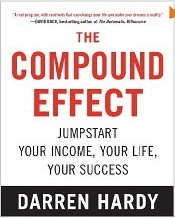Darren Hardy has written an excellent book called the ‘Compound Effect,’ where he states basically that success is a gradual and consistent effort towards achieving a goal. We have all heard the story of the tortoise and the hare. The tortoise wins because he is slow, consistent and does not deviate from the goal. Set your mind on a specific goal, work daily towards that goal and you will achieve it eventually.
In the “Compound Effect” Darren Hardy details a story of three men and how small changes in their daily behavior had major effects on their health, finances and family life.
 Three Friends Let’s take three buddies who all grew up together. They live in the same neighborhood, with very similar sensibilities. Each makes around $50,000 a year. They’re all married and have average health and body weight, plus a little bit of that dreaded “marriage flab.”
Three Friends Let’s take three buddies who all grew up together. They live in the same neighborhood, with very similar sensibilities. Each makes around $50,000 a year. They’re all married and have average health and body weight, plus a little bit of that dreaded “marriage flab.”
Friend number one, let’s call him Larry, plods along doing as he’s always done. He’s happy, or so he thinks, but complains occasionally that nothing ever changes.
Friend number two, Scott, starts making some small, seemingly inconsequential, positive changes. He begins reading 10 pages of a good book per day and listening to 30 minutes of something instructional or inspirational on his commute to work. Scott wants to see changes in his life, but doesn’t want to make a fuss over it. He recently read an interview with Dr. Mehmet Oz in SUCCESS magazine and chose one idea from the article to implement in his life: He’s going to cut 125 calories from his diet every day. No big deal. We’re talking maybe a cup of cereal less, trading that can of soda for a bottle of seltzer, switching from mayo to mustard on his sandwich. Doable. He’s also started walking a couple thousand extra steps per day (less than a mile). No grand acts of bravery or effort. Stuff anyone could do. But Scott is determined to stick with these choices, knowing that even though they’re simple, he could also easily be tempted to abandon them.
Friend number three, Brad, makes a few poor choices. He recently bought a new big-screen TV so he can watch more of his favorite programs. He’s been trying out the recipes he’s seen on the Food Channel—the cheesy casseroles and desserts are his favorites. Oh, and he installed a bar in his family room and added one alcoholic drink per week to his diet. Nothing crazy; Brad just wants to have a little more fun.
At the end of five months, no perceivable differences exist among Larry, Scott, or Brad. Scott continues to read a little bit every night and listen to audios during his commute; Brad is “enjoying” life and doing less. Larry keeps doing as he always has.
Even though each man has his own pattern of behavior, five months isn’t long enough to see any real decline or improvement in their situations. In fact, if you charted the three men’s weights, you’d see a rounding error of zero. They’d look exactly equal.
At the end of ten months, we still can’t see noticeable changes in any of their lives. It’s not until we get to the end of the eighteenth month that the slightest differences are measurable in these three friends’ appearances.
But at about month twenty-five, we start seeing really measurable, visible differences. At month twenty-seven, we see an expansive difference. And, by month thirty-one, the change is startling. Brad is now fat while Scott is trim. By simply cutting 125 calories a day, in thirty-one months, Scott has lost thirty-three pounds!
- 31 months = 940 days 940 days x 125 calories/day = 117,500 calories
- 117,500 calories divided by 3500 calories per pound = 33.5 pounds!
Brad ate only 125 more calories more a day in that same time frame, and gained 33.5 pounds. Now he weighs 67 pounds more than Scott!
But the differences are more significant than weight. Scott’s invested almost one thousand hours reading good books and listening to self-improvement audios; by putting his newly gained knowledge into practice, he’s earned a promotion and a raise. Best of all, his marriage is thriving. Brad? He’s unhappy at work, and his marriage is on the rocks. And Larry? Larry is pretty much exactly where he was two and half years ago, except now he’s a little more bitter about it.
The phenomenal power of the Compound Effect is that simple. The difference between people who employ the Compound Effect for their benefit compared to their peers who allow the same effect to work against them is almost inconceivable.
It looks miraculous! Like magic or quantum leaps. After thirty-one months (or thirty-one years), the person who uses the positive nature of the Compound Effect appears to be an “overnight success.” In reality, his or her profound success was the result of small, smart choices, completed consistently over time.
Understanding and following the concept of the compound effect is particularly vital in network marketing. It takes time, effort and training to be successful in building a network. It takes consistent daily planned goals directed at a particular outcome to achieve financial success. This requires a solid networking company, a superior training program and leaders that will support you throughout the process.
If you want to succeed in building a network marketing team. Take as much time as necessary to learn how to market on the internet, believe in your product, leadership and training system

